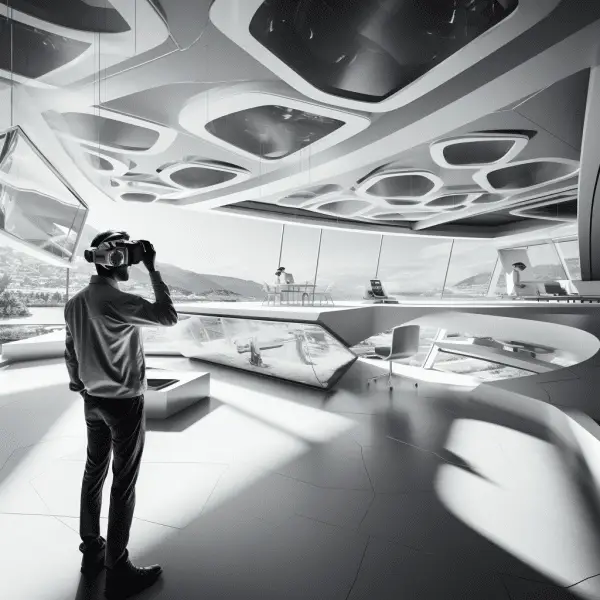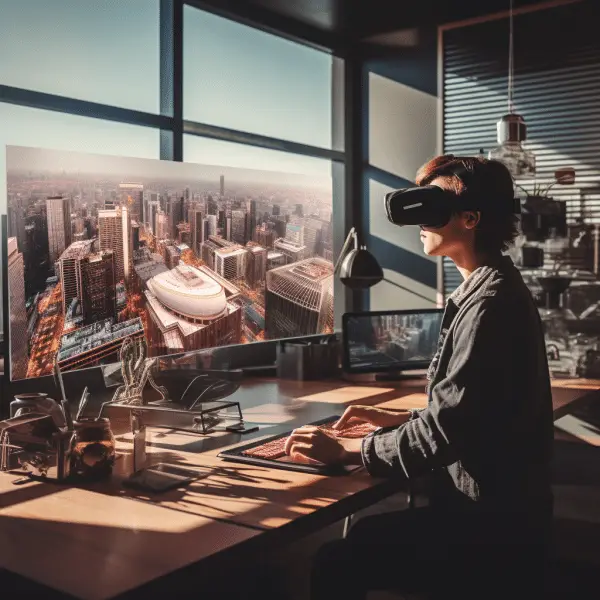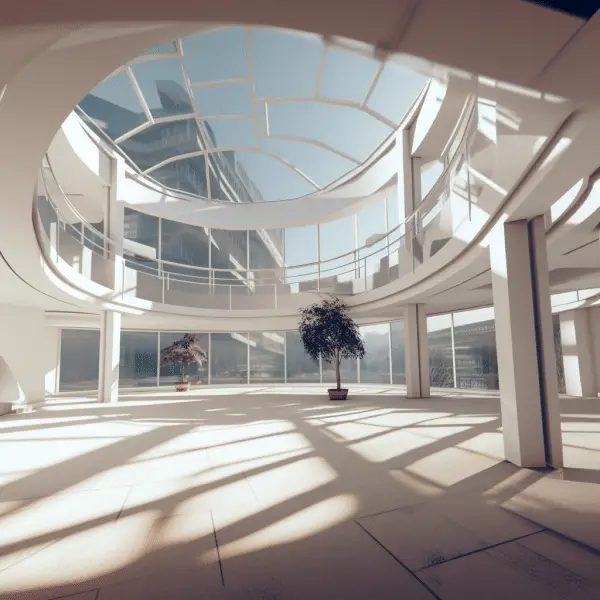Revolutionizing Design: Virtual Reality in Architecture Explained
Virtual reality technology has revolutionized the field of architectural design, providing architects with a powerful tool to create immersive and realistic building designs. With virtual reality (VR), architects can now visualize their designs in a way that was not possible before. VR allows them to explore and navigate through virtual spaces, gaining a deeper understanding of the design and its functionality.
Key Takeaways:
- Virtual reality enhances the design experience in architectural projects.
- Architects can use VR to visually and spatially navigate through virtual spaces.
- VR headsets like Oculus Rift and HTC Vive have made VR technology more accessible and affordable for architects.
- VR improves the client experience, collaboration among project stakeholders, and reduces project costs.
- VR is changing the way architects communicate and visualize their designs, with traditional 2D drawings becoming less relevant.
The Advantages of Virtual Reality in Architectural Design
Virtual reality in architectural design has many benefits that are changing how architects work. This cutting-edge technology lets architects create immersive experiences that bring their plans to life, giving clients a genuine feeling of space, scale, and materials. VR helps architects express their design ideas better than 2D representations.
Virtual reality in architecture design improves customer experience. VR lets clients visually explore their future building or area, including each room, lighting conditions, and spatial relationships. The interactive experience helps clients give more accurate feedback and make informed selections, resulting in a more satisfactory outcome.
VR improves collaboration too. Architects, engineers, and interior designers can cooperate virtually, making real-time modifications and discussing design possibilities. This simplified communication approach reduces mistakes and misunderstandings, making design more efficient and unified.
Virtual reality allows architects to find design problems and fix them before construction, lowering project costs. In the virtual environment, architects can simulate situations, test natural lighting, and examine acoustics. By identifying difficulties early, architects can avoid costly building revisions, saving time and money.

The Advantages of Virtual Reality in Architectural Design:
| Advantages | Description |
|---|---|
| Enhanced client experience | Immersive virtual walkthroughs provide clients with a realistic sense of space and enable better decision-making. |
| Improved collaboration | Virtual reality facilitates real-time collaboration among project stakeholders, leading to better coordination and fewer errors. |
| Cost savings | By catching design flaws early on, virtual reality helps avoid costly changes during construction. |
In conclusion, virtual reality technology offers significant advantages for architects in the field of architectural design. Its immersive capabilities enhance the client experience, improve collaboration, and reduce project costs. As VR continues to evolve, it is expected to become an indispensable tool for architects, transforming the way they communicate, visualize, and optimize their designs.
Navigating Virtual Spaces with VR Technology
Virtual reality lets architects navigate virtual spaces with remarkable precision and realism, helping them understand their designs. Architects can experience their ideas in virtual settings using VR headsets like Oculus Rift and HTC Vive. This groundbreaking technology lets architects visually and spatially explore every area of their designs, revealing their utility and flow.
By walking through their virtual buildings in VR, architects can examine every aspect and how different elements interact. Light and shadow, acoustics, and spatial proportions can be experienced. This level of immersion and engagement helps architects see their projects and make better judgments.
VR also lets architects show clients, stakeholders, and construction teams their virtual spaces. Instead of static photos or real models, architects can create a dynamic walkthrough that accurately depicts their concept. This improves client understanding and collaboration because all stakeholders can visualize the design in a shared virtual space and provide real-time input.
| Benefits of Navigating Virtual Spaces with VR Technology: |
|---|
| 1. Enhanced spatial understanding: VR facilitates a deeper comprehension of architectural designs by allowing architects to physically explore virtual spaces. |
| 2. Realistic evaluation: Architects can simulate lighting, acoustics, and other environmental factors, enabling accurate assessments before construction begins. |
| 3. Improved collaboration: VR experiences can be shared with clients and project stakeholders, fostering clearer communication and more effective decision making. |
| 4. Efficient design iterations: Virtual spaces can be easily modified and adjusted, saving time and resources compared to traditional physical prototyping. |
The Future of Architectural Design
As virtual reality continues to advance, it is opening new frontiers in architectural design. With ongoing developments in VR technology, architects can expect even greater realism, interactivity, and functionality in their virtual explorations. The integration of VR with other emerging technologies, such as augmented reality and artificial intelligence, holds the potential for further innovation and optimization in the architecture industry. By embracing VR and staying at the forefront of these technological advancements, architects can shape the future of the profession and redefine how we experience and interact with the built environment.
VR Headsets: Accessible and Affordable Tools for Architects
VR headsets have made virtual reality technology affordable and accessible for architects, making it essential for architectural design. Using cutting-edge technology like Oculus Rift and HTC Vive, architects can immerse themselves and their clients in a realistic and interactive virtual environment.
VR headsets let architects visualize and spatially explore their projects, improving their understanding of space, scale, and utility. This helps them make better design decisions and interact with clients and project stakeholders. Architects can save time and money by testing the design in a virtual environment before construction.
VR headsets also make VR technology more affordable for architects. Recent price drops have made VR technology affordable for professionals of all sizes and budgets. This accessibility has democratized VR in architectural design, allowing more architects to use it.
In conclusion, VR headsets have revolutionized architecture design by providing a realistic approach to explore and display designs. VR headsets help architects create more engaging and functional designs due to their increased accessibility and cost. As the industry adopts VR technology, architectural design will improve and expand.
Transforming Communication and Visualization in Architecture
VR has changed how architects communicate and visualize their concepts, making client and stakeholder experiences more immersive and engaging. VR lets architects construct realistic virtual settings to showcase their concepts. Customers can see the finished product before construction begins, improving understanding and communication between project parties.
Exploring designs in space is a major benefit of VR in architecture. Virtual worlds allow architects to see scale and perspective that 2D drawings and renderings cannot. This immersive experience lets architects evaluate the design’s functioning and flow before construction, noting any flaws or improvements. Through visual and spatial exploration, architects may make better judgments and assure a successful project.
Beyond its benefits for architects, VR technology allows clients to more deeply connect with the design. As VR devices like Oculus Rift and HTC Vive become more cheap, clients may experience the design in virtual reality. This improves understanding and builds faith in the architect’s vision. It lets clients give input and make informed decisions, resulting in a design that suits their goals.
| Benefits of VR in Architecture: |
|---|
| Enhanced design understanding |
| Improved communication and collaboration |
| Cost reduction |
- Visualization in a spatial context
- Realistic representation of architectural designs
- Ability to identify issues or improvements before construction
- Enhanced client experience and engagement
- Building trust and confidence in the design
“Virtual reality allows us to step into our designs, to see and experience them in ways that were not possible before. It has revolutionized the way we communicate and collaborate with our clients, bringing our designs to life and creating a truly immersive experience.” – Architect
The Future of Architecture: VR as an Optimization Tool
As we look to the future of architecture, virtual reality is poised to take on an even more significant role. The use of VR technology as an optimization tool has the potential to streamline the design and construction process, resulting in more efficient and sustainable buildings. By simulating various environmental factors such as lighting, acoustics, and energy efficiency, architects can make more informed decisions that optimize the building’s performance.
Virtual reality in architectural design is here to stay, changing the way architects communicate, collaborate, and visualize their designs. With its immersive and engaging experience, VR technology offers a new and innovative way to bring architectural visions to life. By embracing VR, architects can stay ahead in the evolving industry and continue to deliver exceptional designs that exceed client expectations.
Improving Project Analysis with VR Technology
Virtual reality lets architects simulate real-world settings for a deeper design knowledge. Creating immersive virtual environments lets architects test lighting, acoustics, and other environmental aspects on their designs. This improves analysis, helping architects make informed decisions and optimise designs for functionality and user experience.
VR lets architects walk through the design and see it from numerous angles. This level of spatial awareness can discover challenges and propose new solutions that 2D drawings or computer-generated renderings alone could not.
VR technology improves project analysis and stakeholder participation. Architects, clients, and other stakeholders can collaborate and make real-time choices virtually. This increases communication, reduces misconceptions, and speeds up approval, reducing project deadlines and costs.
| Benefits of Virtual Reality in Project Analysis: |
|---|
| 1. Enhanced visualization and spatial understanding |
| 2. Accurate simulation of real-world conditions |
| 3. Improved collaboration among project stakeholders |
| 4. Streamlined decision-making process |
| 5. Optimized designs for functionality and user experience |
As VR technology continues to evolve, architects can expect even more advanced capabilities for project analysis. The integration of artificial intelligence and machine learning algorithms can further enhance the accuracy and efficiency of simulations, providing architects with valuable insights and data-driven recommendations.
The Future of Architecture: VR as an Optimization Tool
Virtual reality will transform architecture by helping architects maximize design and construction. VR technology allows architects to immerse themselves and their clients in realistic virtual settings, making design more interesting.
VR aids stakeholder collaboration in architecture. Architects, clients, and contractors can interact with virtual places to provide feedback and ensure alignment. Collaborative communication improves accuracy and avoids misconceptions.
Along with teamwork, VR in architecture helps cut project expenses. By seeing and exploring designs in a virtual environment, architects can find and fix design defects early, saving time and money. VR simulates construction processes, making them more efficient and smooth.
| Benefits of VR in Architecture: |
|---|
| Improved client experience |
| Enhanced collaboration among project stakeholders |
| Reduced project costs |
| Efficient project analysis |
| Optimization of the design and construction process |
In conclusion, virtual reality is revolutionizing the field of architecture by providing architects with the ability to optimize the design and construction process. By harnessing the power of VR technology, architects can enhance collaboration, reduce costs, and improve project analysis. As VR continues to advance, it is clear that the future of architecture lies in embracing this exciting and transformative tool.
The Impact of VR on Traditional Architectural Rendering
Virtual reality technology is revolutionizing the field of architectural rendering, rendering traditional 2D drawings and renderings less relevant in the face of immersive VR experiences. With VR, architects and clients can now step inside a virtual building or space and explore it from every angle, gaining a true sense of its design, scale, and ambiance.
VR allows architects to visually and spatially navigate through their designs, providing a level of immersion and understanding that cannot be achieved with traditional renderings. Architects can walk through virtual rooms, examine detailed elements, and experience the spatial flow of a design before it is built. This level of interaction and realism enhances the design process, ensuring that every aspect is thoroughly considered and refined.
Additionally, VR headsets such as Oculus Rift and HTC Vive have made this technology more accessible and affordable for architects. Gone are the days of expensive and cumbersome physical models or static renderings. Architects can now easily showcase their designs using VR, enabling clients to walk through their future spaces and make more informed decisions.
Furthermore, the use of VR in architectural rendering has far-reaching benefits. It improves collaboration among project stakeholders by allowing them to visualize and understand the design in a shared virtual space. It reduces project costs by identifying design issues early on and minimizing changes during construction. It also enhances project analysis by simulating lighting, acoustics, and other environmental factors to inform design decisions.
In summary, virtual reality is transforming the way architects present and visualize their designs. By providing an immersive and realistic experience, VR is challenging the traditional methods of architectural rendering. As the industry continues to embrace VR technology, it offers new opportunities to optimize the design and construction process, ultimately leading to more efficient and sustainable buildings.

Conclusion
Virtual reality is reshaping the architectural design landscape, offering architects unprecedented opportunities to enhance their design process and deliver exceptional projects. With the advancement of VR technology, architects can now immerse themselves and their clients in virtual environments, providing a more realistic and interactive experience.
By using VR headsets like Oculus Rift and HTC Vive, architects can navigate through virtual spaces, gaining a deeper understanding of the design’s layout and functionality. This allows for better communication and collaboration among project stakeholders, leading to improved design outcomes and client satisfaction.
Furthermore, the use of VR in architecture has the potential to reduce project costs by identifying design flaws and making necessary adjustments before construction begins. Architects can simulate lighting, acoustics, and other environmental factors, improving project analysis and ensuring optimal building performance.
As the architecture industry embraces VR technology, traditional 2D drawings and renderings are becoming less relevant. Architects now have the capability to convey their ideas and concepts through immersive VR experiences, allowing clients to fully visualize and experience their future space.
Overall, virtual reality is revolutionizing the architectural design process and paving the way for a more efficient and sustainable future. Architects who embrace this technology will be at the forefront of innovation, delivering exceptional designs and transforming the way we perceive and interact with architecture.
FAQ
Q: How can virtual reality be used in architectural design?
A: Virtual reality technology allows architects to visually and spatially navigate through virtual buildings or spaces, providing a better understanding of their design and feel.
Q: What are the advantages of using virtual reality in architectural design?
A: Virtual reality can enhance the client experience, improve collaboration among project stakeholders, reduce project costs, and improve project analysis.
Q: How does virtual reality technology allow architects to navigate virtual spaces?
A: Virtual reality technology enables architects to visually and spatially explore their designs, gaining a deeper understanding of the design and its functionality.
Q: Are VR headsets accessible and affordable for architects?
A: Yes, VR headsets such as Oculus Rift and HTC Vive have made VR technology more accessible and affordable for architects.
Q: How is virtual reality transforming communication and visualization in architecture?
A: Virtual reality is changing the way architects communicate and visualize their designs, with 2D drawings and renderings becoming less relevant.
Q: How does virtual reality technology improve project analysis in architectural design?
A: Virtual reality technology allows architects to simulate lighting, acoustics, and other environmental factors, improving the accuracy and efficiency of project analysis.
Q: What is the future of architecture with virtual reality?
A: Virtual reality is seen as the future of the industry, offering new ways to optimize the design and construction process.
Q: How is virtual reality impacting traditional architectural rendering?
A: Virtual reality is shifting the focus away from traditional 2D drawings and renderings, making immersive VR experiences the primary means of visualizing architectural designs.








